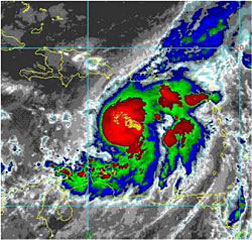- Number 372 |
- September 24, 2012
Fresh water feeds hurricanes' fury

Still images looped into video show Omar's
rapid intensification to a Category 4 storm.
Hurricane Omar in 2008 ripped through the
eastern Caribbean with winds up to 135 miles
per hour, causing death and extensive
damage. Images courtesy of the National
Oceanic and Atmospheric Administration.
When hurricanes blow over ocean regions swamped with fresh water, the storm can unexpectedly intensify. According to a new study led by researchers at DOE’s Pacific Northwest National Laboratory and published in the Proceedings of the National Academy of Sciences Early Edition, the probability that hurricanes will hit these conditions is small—about 10 to 23 percent—the rate at which they intensify can be higher when they do, by as much as 50 percent on average.
"Sixty percent of the world's population lives in areas affected by tropical cyclones," said Dr. Karthik Balaguru, lead author of the study and oceanographer at PNNL. "Cyclone Nargis killed more than 138,000 people in Burma in 2008. We can predict the paths cyclones take, but we need to predict their intensity better to protect people susceptible to their destructive power."
While satellites are useful for tracking and helping to predict the path of tropical storms, current technologies are not as good at predicting how intense the storm will be when it does hit land. This study provides insight into the conditions that make storms more intense and destructive.
"A 50 percent increase in the intensity can result in much stronger hurricanes and consequently a larger amount of destruction and death," said Balaguru.
Balaguru and the team looked at Omar, a Category 4 hurricane over the eastern Caribbean Sea in 2008. They found that regions of the ocean where there is a large influx of fresh water sets up conditions that form a layer between the surface and the colder ocean below. The barrier layer created by the fresh water prevents typical ocean mixing and cooling of the surface layer by strong winds. The most intense activity of Omar occurred when the storm traveled over this thick layer.
Balaguru and colleagues then examined 587 tropical storms and cyclones between 1998 and 2007. They compared storms that passed over a thick ocean barrier layer and storms that did not. They found that when a tropical storm passed over a thick ocean barrier layer, the ocean surface did not cool off as much as when the storm passed over areas without barrier layers. Reduced surface cooling translates to a stronger storm.
This work addressed what happens to hurricanes now. Scientists predict that global warming will effect the ocean water cycle. Future research could explore how the distribution of the barrier layers changes in a warmer world.
This work was funded by DOE’s Office of Science, the U.S. National Science Foundation, the National Science Foundation of China, and the Chinese Ministry of Education.
[Kristin Manke, 509.372.6011,
kristin.manke@pnnl.gov]
